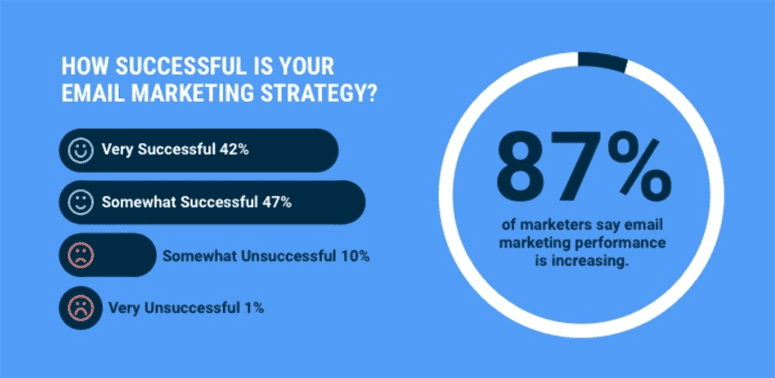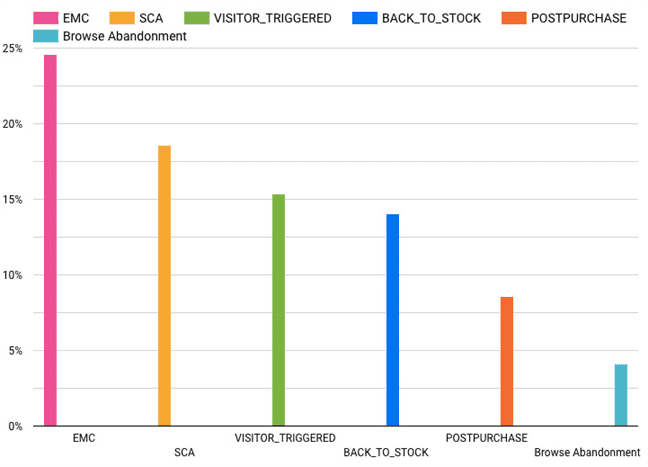Artificial intelligence! Chatbots! Influencers! The digital marketing landscape is always brimming with new and exciting trends, all of which promise to lure customers with fresh tactics and innovative technology.
But sometimes the most effective marketing strategies are built on decades-old technologies—good old-fashioned email, for example. With a little creativity and a lot of attention to detail, you can turn your future email campaigns into conversion-generating powerhouses. Ready to get results? Start tracking the email marketing metrics that matter.
- Why You Need to Pay More Attention to Email Marketing Metrics
- Delivery Rate and Deliverability
- Open Rate
- Click-Through Rate
- Conversion Rate
- Unsubscription Rate
- List Growth
Why You Need to Pay More Attention to Email Marketing Metrics
You might associate the birth of widespread email usage with the 1990s, but it first came into existence much earlier. Incredibly, the first email ever was sent when Nixon was in office. It may be ancient by tech standards, but email marketing is still shockingly effective.
One of the primary causes of its success may be its sheer ubiquity. In 2019, there were 3.9 billion email users worldwide, or more than half of the global population for that year.
Even with an array of social media platforms competing for views, clicks and dollars, email marketing continues to generate strong results. A survey from email marketing platform Campaign Monitor found 89 percent of marketers view their email strategy as either somewhat or very successful, and 87 percent say performance is increasing:
To be successful in the 21st century, though, email campaigns need more than a catchy message—they also need to be informed by hard data. You can analyze key email marketing metrics to:
- see what is and isn’t working;
- monitor growth;
- understand who your emails resonate with; and
- measure each campaign’s cost and profits.
Want to take your next email marketing campaigns to the next level? Get ready to dig into some numbers.
Delivery Rate and Deliverability
Before you consider metrics like open and conversion rates, you need to know whether your emails are actually reaching recipients’ inboxes in the first place.
You can find out with the help of two related metrics:
- delivery rate, which indicates whether an email was received by the recipient’s email provider; and
- deliverability, which indicates whether an email reached the recipient’s inbox or was delivered elsewhere, such as their spam folder.
Delivery Rate
An email’s failure to reach a recipient’s email provider is called a bounce. An email can bounce for several reasons. The recipient’s email address may be invalid, or their email server may be temporarily down. While a small number of bounces are inevitable—a bounce rate of two percent or lower is typically deemed acceptable—you can take steps to minimize their frequency.
To improve delivery rate and reduce bounce rate, you can try:
- using a two-step opt-in process asking recipients to confirm their subscription via email;
- regularly purging invalid email addresses from your subscriber list; and
- refraining from purchasing recipients’ email addresses from third-party sources.
Deliverability
Next, check to see whether your emails are being sent to the junk pile. To improve deliverability and steer clear of the spam folder:
- create engaging and high-quality email content recipients will be less likely to mark as spam;
- authenticate your domain to demonstrate trustworthiness to internet service providers (ISPs);
- observe email list hygiene best practices;
- make it easy for recipients to unsubscribe from your list;
- send emails only to recipients who have opted to receive them; and
- warm up your IP address if you just started sending from it.
Open Rate
After learning how to reduce your bounce rate and sidestep the dreaded spam folder, you’re free to move on to more fun email marketing metrics (yeah, we think metrics are fun, what of it?). One of the most basic is open rate, an email marketing optimization staple.
As its name suggests, open rate refers to the rate at which recipients actually open and presumably read your emails.
Mailchimp, an email marketing service with more than 12 million active customers in 2019, reports the average open rate across all industries to be 21.33 percent.
Setting a realistic target for your own open rate depends on understanding both the average open rate for your industry and techniques for improving upon it.
Rates can vary significantly based on vertical. For example, government emails have a sky-high open rate of 28.77 percent, while emails from the vitamin and supplement industry have a comparatively low rate of just 15.03 percent. So check your industry’s average before judging your own open rate too harshly.
To increase your open rate:
- use personalized subject lines;
- avoid generic or spammy-sounding subject lines;
- create intriguing preview text;
- regularly purge inactive addresses from your email list;
- switch up your emails’ frequency; and
- send emails at different times or on different days of the week.
Click-Through Rate
Notice how each metric takes us further along the customer journey. First, the email arrives in their inbox. Second, they open the email. Next, they have the choice to either go back to their inbox and keep scrolling or click a link within the email to visit an external website.
The percentage of recipients who choose to click a link is the click-through rate, or CTR for short.
Expect your CTR to be much lower than your open rate. Mailchimp’s data shows the average CTR across all industries is 2.62 percent, with hobby-related emails taking first place (5.01 percent) and emails from the restaurant industry coming in last (1.34 percent).
To improve your CTR:
- optimize your emails for both mobile and desktop devices;
- experiment with different link and button placements;
- add personalized elements for each recipient;
- send custom-tailored emails to each customer segment;
- use high-quality images and graphics;
- fine-tune the call to action (CTA); and
- keep each email succinct, well organized and easy to read.
Conversion Rate
You’re not creating email campaigns just for kicks—you’re using them to convince recipients to take a desired action, or convert.
The form that action takes will vary based on your vertical and intentions. For instance, if you’re optimizing campaigns for a software as a service (SaaS) company, your goal will likely be to secure software subscriptions. If you’re optimizing campaigns for a nonprofit organization, though, your goal might be for recipients to donate or volunteer.
Whatever the case, your conversion rate is defined by the percentage of recipients who take the desired action.
Since desired conversions vary, it’s difficult to pin down a general or even industry average. You can set your own target conversion rate based on your email campaigns’ historical performance.
To boost your conversion rate, use all the same tactics you would use to increase your open rate and CTR.
If your desired conversion involves recipients making a purchase, you may also find it useful to send emails triggered by their actions. Data gathered in 2020, from ecommerce email campaigns found email my cart (EMC) emails garner the highest average conversion rates by far:
Unsubscription Rate
Email list recipients unsubscribe for a number of reasons. Perhaps they only signed up to get an introductory offer, or maybe they’re simply trying to clean up a crowded inbox. Your unsubscription rate refers to the percentage of recipients who do so, regardless of motive.
Though it may seem counterintuitive, unsubscriptions aren’t necessarily a bad thing. In fact, they can even help your email marketing optimization efforts. Think of them as free list cleanup—each recipient who manually unsubscribes is one you won’t have to remove from your list later.
That said, a higher-than-usual unsubscription rate can provide insights into what your recipients are responding to and what’s turning them off.
Mailchimp’s data shows average unsubscription rates are less than 0.50 percent across the board, with an overall average of 0.26 percent. Emails from the health and fitness industry and the photo and video industry are tied for the highest rate (0.40 percent), while daily deals and e-coupons claim the lowest (0.10 percent).
Depending on your industry, you may be able to drive down your unsubscription rate by creating more engaging content or including more enticing offers.
List Growth
The rate at which visitors and potential customers opt in to receive your emails is known as list growth, and may also be referred to as opt-in rate or signup rate. This email marketing metric is essential for gauging your audience’s interest in your content, products or services.
Email capture tool Sumo reports its own list growth rate at 1.95 percent—and it’s in good company. The research institute MarketingSherpa says email lists across all industries are growing by an average of 5.2 percent each month.
Your list growth will vary depending on your target audience. If you’re encouraging existing customers to sign up, list growth will likely be much higher than if you’re cold emailing people who have never heard of your organization before.
If your list growth isn’t where you want it to be, it may help to:
- add email capture tools like pop-ups or floating sign-up bars to the organization’s site;
- offer exclusive content, giveaways or original research in exchange for email sign-ups;
- add a CTA button to the organization’s Facebook page;
- link to the email sign-up landing page from the organization’s social media profiles; and
- add an opt-in button next to comment boxes and account creation forms.
Mine Email Marketing Metrics for Insight-Driven Results
In a world of machine learning-based marketing techniques and brand new ad formats (augmented reality, anyone?), email marketing campaigns might seem dull in comparison.
Nevertheless, tried and true email technology can be one of the most invaluable tools in your arsenal. By tracking the right email marketing metrics and paying attention to ever-evolving trends, you can master email marketing campaign optimization to get more clicks, conversions, and subscribers.
Image credits
Campaign Monitor / July 2019
Barilliance / July 2020






